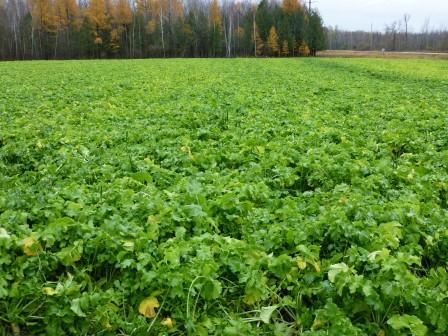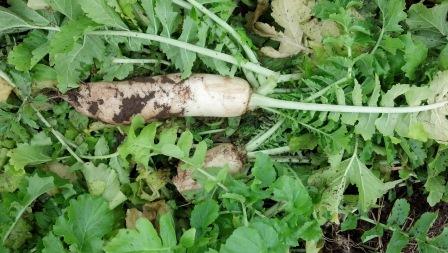Radishes, Crimson Clover, and Bears
Walking in cover crop fields in northern Indiana is easy compared to doing it northern Wisconsin.
In northern Indiana my main issue is tripping over large radish tubers sticking out of the ground.
In northern Wisconsin my main issue was that plus watching out for bears. I’m not talking about the Chicago Bears…but real live black bears! Although I did not see any while conducting cover crop field days near Coleman, WI on October 18, 2012, hearing the stories about the bears raising havoc while AgVentures Co-op employees were harvesting corn plots made me quite nervous.
The cover crop plot was fabulous. There were 5 different mixes to observe plus straight radishes planted at 8#/acre. The cooperator plans on taking yield tests over each different cover crop mix in his 2013 corn crop. If he is able to do that I’ll keep you informed of the results.

- The radishes were from 1″ to 3″ in diameter and quite deeply rooted. There was manure applied after wheat harvest so the radishes were “well fed”.

Maybe you can make it to Northerrn Wisconsin, you were only half way up the state. I am 4 hours farther North. But I am interested in the Crimson Clover.
Stan, That was North for my normal travels! HA! Crimson Clover after a cereal crop would be awesome up your way!
I read that 8# is seeding rate for raddish , is 3 # the rate for turnip ? If the seed is coated and only65 % pure ,due to coating , should we plant 35 % more ? Other than the seed company making more profit per pound , why coat cover crop seed ?
Hey Weedman. I’d say 8# is tops for straight Radish and 2-3# on turnips in most cases unless grazing. But, I’d prefer both in mixes regardless. Coated or non-coated. Why coat? Clovers and alfalfa especially respond well to coating when it comes to getting a better stand. One reason to coat radishes is that the coating is quite hydroscopic, thus helping get a better stand in less than ideal conditions. If the radishes are planted into dry soil, or flown onto dry soil, a coated radish may very well germinate more quickly when a light rain comes. Now, that is NOT a guarantee. Another benefit is that many coated radishes also have germination enhancers encapsulated in the coating material that enhances the seedling vigor. It’s not really a “money maker” for the seed company as oftentimes coated seed costs less than Raw and the seeding rate should be the same (5# Raw = 5# coated seed). If someone is telling you to seed more coated pounds then maybe they are trying to make more $$. I know that aerial applicators often like the way coated radishes have better ballistics. For me? I’m just fine with Raw Radishes and turnips most of the time and generally always in favor of coated clover and alfalfa. I definitely see an advantage on them. Oh, coated Annual Ryegrass was tried a few years ago…don’t do that. You do need to increase the rate with coated grasses and it is too expensive to get any benefit with that.